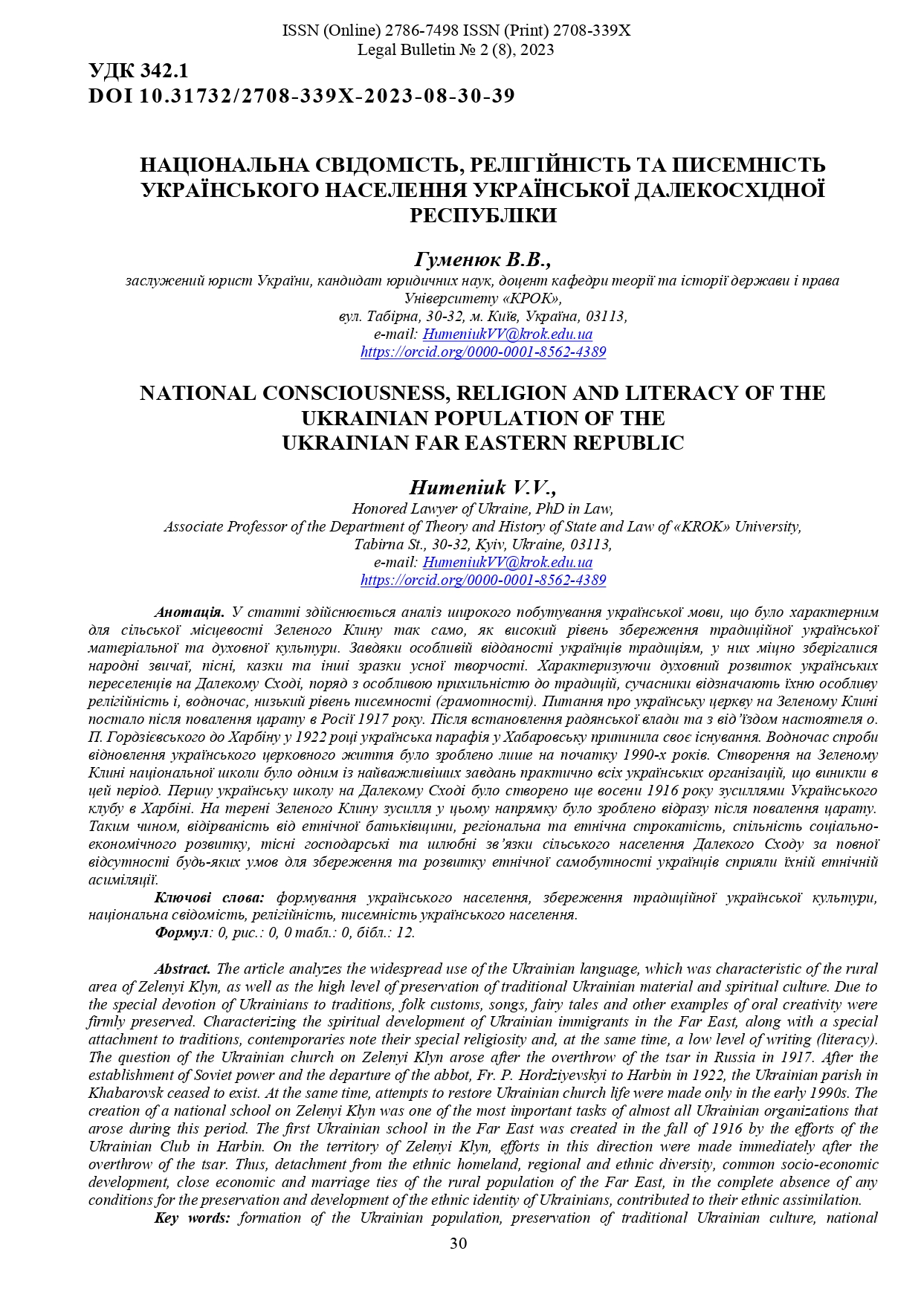NATIONAL CONSCIOUSNESS, RELIGION AND LITERACY OF THE UKRAINIAN POPULATION OF THE UKRAINIAN FAR EASTERN REPUBLIC
DOI:
https://doi.org/10.31732/2708-339X-2023-08-30-39Keywords:
formation of the Ukrainian population, preservation of traditional Ukrainian culture, national consciousness, religiosity, literacy of the Ukrainian populationAbstract
The article analyzes the widespread use of the Ukrainian language, which was characteristic of the rural
area of Zelenyi Klyn, as well as the high level of preservation of traditional Ukrainian material and spiritual culture. Due to
the special devotion of Ukrainians to traditions, folk customs, songs, fairy tales and other examples of oral creativity were
firmly preserved. Characterizing the spiritual development of Ukrainian immigrants in the Far East, along with a special
attachment to traditions, contemporaries note their special religiosity and, at the same time, a low level of writing (literacy).
The question of the Ukrainian church on Zelenyi Klyn arose after the overthrow of the tsar in Russia in 1917. After the
establishment of Soviet power and the departure of the abbot, Fr. P. Hordziyevskyi to Harbin in 1922, the Ukrainian parish in
Khabarovsk ceased to exist. At the same time, attempts to restore Ukrainian church life were made only in the early 1990s. The
creation of a national school on Zelenyi Klyn was one of the most important tasks of almost all Ukrainian organizations that
arose during this period. The first Ukrainian school in the Far East was created in the fall of 1916 by the efforts of the
Ukrainian Club in Harbin. On the territory of Zelenyi Klyn, efforts in this direction were made immediately after the
overthrow of the tsar. Thus, detachment from the ethnic homeland, regional and ethnic diversity, common socio-economic
development, close economic and marriage ties of the rural population of the Far East, in the complete absence of any
conditions for the preservation and development of the ethnic identity of Ukrainians, contributed to their ethnic assimilation.
References
Чорномаз В. Зелений Клин (Український Далекий Схід). Енциклопедичний довідник. Наукове товариство
україністів ім. Т.Г. Шевченка. 2011. URL: https://diasporiana.org.ua/ukrainica/zelenyj-klyn-enczyklopedychnyj-dovidnyk/
(дата звернення: 21.05.2022).
Українство на Далекому Сході // Нова Україна. Календар на рік 1921-й. Владивосток, 1921.С.127-128.
Субтельний О. Україна. Історія. Київ, 1991. С. 242.
Новицький М. Зелений Клин (Приморщина). Харків, 1928. С. 20, 39-41.
Кабузан В.М. Переселення українців у Далекосхідний край // Український історичний журнал. 1971. № 2.
С.69-70.
Позняк Т.З. Динаміка станового складу міст Приморської області наприкінці XIX – на початку XX ст. //
Історичний досвід відкриття, заселення та освоєння Далекого Сходу Росії. Владивосток, 1993. Кн.1. С. 70.
Фетісова Л.Є. Етнографічне вивчення міст Приамур’я та Примор’я // Далекий Схід Росії у контексті
світової історії: від минулого до майбутнього. Матеріали міжнародної наукової конференції Владивосток. 1997.
С.235.
Від Владивостока до Уральська. Путівник до подорожі Його Імператорської Високості Государя
спадкоємця Цесаревича. Центральний Статистичний Комітетом МВС. СПб., 1891. С. 509
Оліфіренко В.В. Підручники з української літератури для східної діаспори. Проблеми сучасного
підручника середньої і вищої школи. Зб. наук. праць. Випуск 3. / Упорядкування і наукова редакція: В.В. Оліфіренко,
В.С. Білецький. – Д: Східний видавничий дім. 2005. 108 с.
Мижевський П. Засланці-українці // Рада. 1911.22.12
Світ I. Зелена Україна. Короткий історичний нарис українського політичного і громадського життя.
Ню-Йорк-Шангай, 1949. С.11.
Георгіївський А.П. Діалектологія Далекосхідного краю. С.49.

Downloads
Published
How to Cite
Issue
Section
License
Copyright (c) 2023 В.В. Гуменюк

This work is licensed under a Creative Commons Attribution 4.0 International License.




